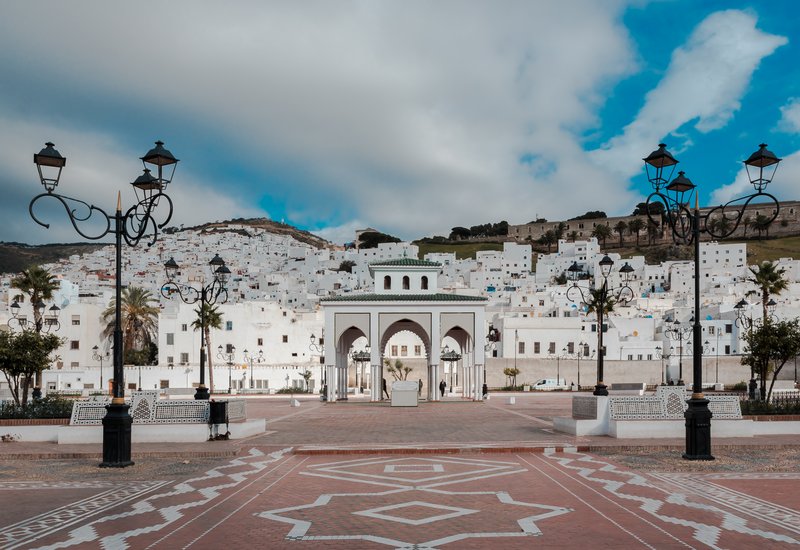Nestled between the dramatic Rif Mountains and the serene Mediterranean coast, Tetouan is a city rich in culture, charm, and history. Known as the “White Dove” for its whitewashed buildings and graceful architecture, this northern Moroccan treasure offers an authentic experience far removed from the bustle of more tourist-heavy cities.
Table of Contents
Andalusian Legacy: A City of Refuge and Revival
Tetouan’s identity was deeply shaped in the late 15th century, when Muslim and Jewish refugees from Andalusia arrived following the fall of Granada. These newcomers brought with them refined artistic traditions, architectural sensibilities, and skilled craftsmanship that still echo throughout the city.
The heart of Tetouan is its medina, a UNESCO World Heritage Site, where centuries of heritage are preserved in narrow alleyways, lively markets, and family-run workshops. Wandering through this maze of history, visitors encounter traditional tilework, handwoven carpets, and the scent of spices wafting from busy souks. Cultural landmarks like Dar El Oddi, a restored historical home now serving as a museum, offer deeper insight into Tetouan’s unique story.

A Tale of Two Districts: Medina Meets Modernity
Tetouan’s urban landscape reflects a fascinating blend of Moroccan and European influences. The ancient medina showcases Islamic and Andalusian design, while the Ensanche district—developed during the Spanish protectorate in the early 20th century—features broad avenues, pastel facades, and elegant plazas like Mulay El Mehdi Square.
Together, these two neighborhoods reveal the city’s layered history and offer a visual journey through its evolution.
Nature at Every Turn: From Mountains to Sea
Surrounded by natural beauty, Tetouan is the perfect base for exploring both the mountains and the coast. Along the Mediterranean, beaches such as Cabo Negro and Martil attract visitors looking for sun, surf, and seaside cafes. Just inland, the Rif Mountains offer rewarding hikes, panoramic views, and encounters with untouched landscapes.
For a tranquil escape within the city itself, Feddan Park provides a peaceful setting with lush gardens and scenic viewpoints overlooking the old town.
Flavors of Tetouan: A Culinary Crossroads
Local cuisine in Tetouan reflects its diverse cultural roots and coastal location. Freshly caught fish and seafood are common, often prepared simply and served with local herbs and olive oil. Classic Moroccan dishes like harira (a warming soup) and msemen (layered flatbread) are widely enjoyed, particularly during traditional festivities.
Markets overflow with regional specialties—olives, dates, honey, and handmade sweets—inviting visitors to sample the region’s culinary delights.
Planning Your Visit: Practical Tips
Reaching Tetouan is straightforward, especially for those traveling from Tangier, just about an hour away by bus, shared taxi, or private vehicle. Once in town, the best way to explore is on foot—especially through the medina and central areas.
The ideal times to visit are spring and fall, when the weather is pleasantly mild and ideal for outdoor sightseeing. The city is known for being safe, relaxed, and welcoming, making it an appealing destination for solo travelers, couples, and families alike.
Explore Beyond: Day Trips from Tetouan
Tetouan is also a great jumping-off point for exploring northern Morocco. Nearby, the iconic blue town of Chefchaouen offers a peaceful mountain escape with postcard-worthy streets and calm cafés. For beachgoers, Cabo Negro, Martil, and other coastal spots provide everything from water sports to laid-back lounging.
Tetouan: Where Heritage Meets Horizon
With its stunning blend of Moorish tradition, Spanish influence, and natural beauty, Tetouan offers a travel experience that’s both immersive and inspiring. Whether you’re wandering through its ancient medina, sipping mint tea in a sunny plaza, or watching the sun set over the sea, Tetouan leaves a lasting impression of elegance and authenticity.
Discover a side of Morocco that feels timeless—Tetouan, the White Dove, awaits.
